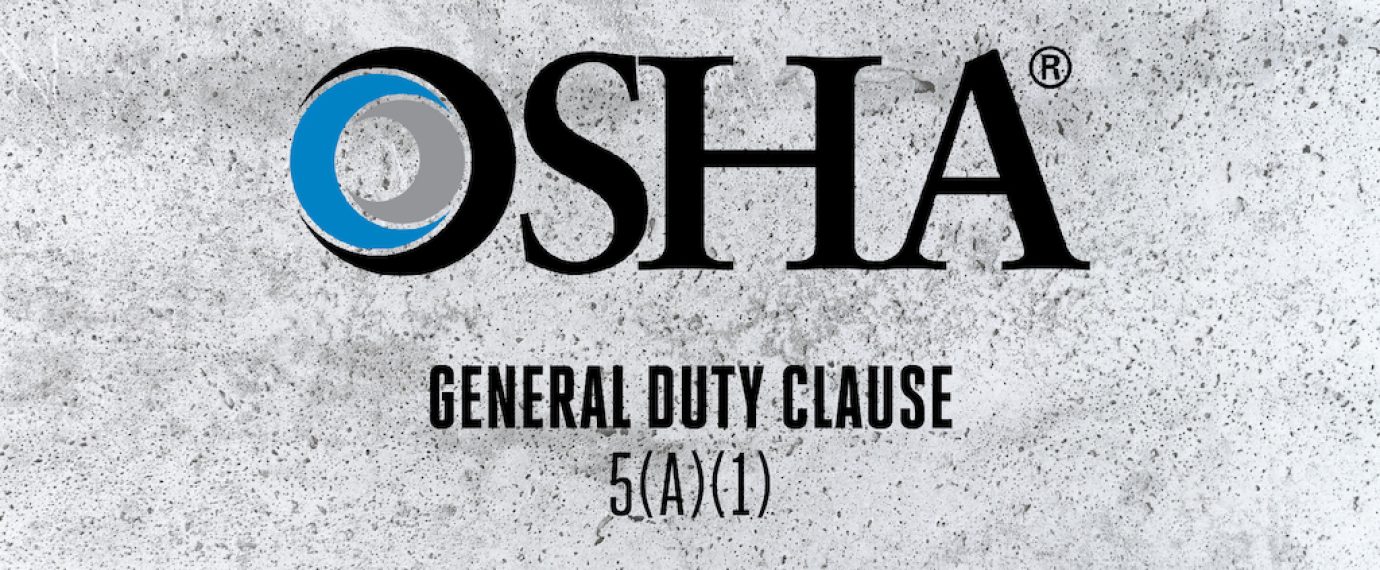
What Is OSHAS General Duty Clause?
Share

What Is OSHAS General Duty Clause?
The General Duty Clause is part of the Occupational Safety and Health Act of 1970. Here's the language of the clause itself, straight from Section 5(a)(1) of the OSH Act:
"Each employer shall furnish each of his employees with employment and a place of employment that is free from recognized hazards that are causing or are likely to cause death or serious physical harm to his employees."
In other words, the General Duty Clause requires employers to protect their employees from serious hazards in the workplace—even if there isn't a specific OSHA standard that addresses those hazards. This broad statement gives OSHA the authority to enforce safety in various scenarios that may not have been anticipated when the particular standards were written.
Why the General Duty Clause Matters to Employers
Employers are used to having rules and regulations that they can reference directly, such as OSHA's standards on machine guarding or fall protection. However, only some workplace hazards fit neatly into these categories. That's where the General Duty Clause comes in. It ensures that employers are responsible for all recognizable dangers that could cause serious harm, even if a specific OSHA rule doesn't cover those hazards.
For employers, understanding and implementing the General Duty Clause is vital for several reasons:
- Proactive Hazard Mitigation: It encourages a proactive approach to safety by requiring employers to address any recognized hazard, not just those explicitly outlined by OSHA.
- Legal Implications: Violating the General Duty Clause can lead to citations and fines, just as with specific OSHA standards. Often, these penalties can be even more severe if it's determined that the employer knew about the hazard and failed to act.
- Employee Trust and Safety Culture: By adhering to the General Duty Clause, employers demonstrate a commitment to a safe workplace, fostering employee trust and strengthening the organization's safety culture.
Real-Life Examples of the General Duty Clause in Action
- Heat Stress in Outdoor Work Environments
In recent years, OSHA has cited employers under the General Duty Clause for failing to protect workers from extreme heat. Although there is no specific federal standard for heat stress, outdoor workers, such as landscapers or construction crews, are at high risk during hot summer months.
Take the example of an outdoor construction site where workers were exposed to direct sunlight and high temperatures. In one case, an employee suffered heatstroke from inadequate shade and water breaks. Even though OSHA has heat guidelines, there isn't a standard for heat stress. Here, OSHA used the General Duty Clause to hold the employer accountable, citing the recognized hazard of heat-related illnesses and the employer's failure to mitigate it.
- Workplace Violence in Healthcare Settings
Healthcare workers often face the risk of workplace violence, which can include anything from verbal threats to physical assault. For instance, nurses and emergency room staff frequently encounter aggressive behavior from patients or family members. While OSHA does have guidelines to address workplace violence, there isn't a specific standard for it. However, there are countless cases where OSHA used the General Duty Clause to cite hospitals and clinics after incidents where workers were injured due to inadequate safety measures against violence.
In one case, a hospital was cited under the General Duty Clause after several staff members were assaulted in the emergency department. OSHA found that the hospital had not provided sufficient security or protocols to prevent these incidents, demonstrating that workplace violence, while complex, is a recognizable hazard that must be addressed.
- Chemical Exposure in Manufacturing Facilities
Consider a manufacturing facility where workers regularly handle chemicals, and some of those chemicals have known, serious health risks, such as chronic respiratory problems or even carcinogenic effects. Even when there's not a specific OSHA standard for every chemical, employers are still responsible for protecting employees from excessive exposure.
One company faced a General Duty Clause citation because employees were regularly exposed to high levels of hazardous substances without adequate ventilation or personal protective equipment (PPE). Since the risk was well-documented, OSHA argued that the employer should have recognized the danger and acted to protect the workers. The General Duty Clause allowed OSHA to enforce safety in the absence of a specific chemical exposure standard.
How Employers Can Stay Compliant with the General Duty Clause
- Identify Recognizable Hazards: Employers should conduct regular risk assessments to identify all potential hazards, even those not covered by specific OSHA standards. Engaging employees in this process can be particularly effective because they are familiar with daily operations and can offer insights into potential risks.
- Implement Preventive Measures: Once a hazard is identified, take action to eliminate or control it. This could mean providing appropriate PPE, modifying processes, or offering regular safety training sessions.
- Document Everything: Thorough documentation is essential for demonstrating your commitment to safety. This includes risk assessments, safety meetings, incident reports, and any corrective actions taken.
- Stay Informed: OSHA often releases guidelines and updates that, while not enforceable standards, provide valuable insights into recognized hazards. For example, OSHA's heat illness prevention campaign offers guidelines for protecting outdoor workers, which employers can implement to ensure compliance with the General Duty Clause.
The Bottom Line
The General Duty Clause is a powerful tool that OSHA uses to enforce safety in scenarios where specific standards don't exist. For employers, it's a reminder that a safe workplace isn't just about following a checklist of regulations; it's about addressing any and all hazards that could harm employees. By being proactive, diligent, and committed to a culture of safety, employers can not only avoid costly citations but also build a workplace where employees feel secure and valued.

Visit: learnwithsafety.com for safety programs and safety trainings presentations for your safety meeting!
